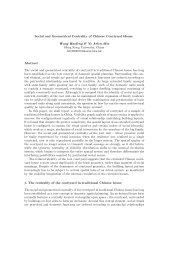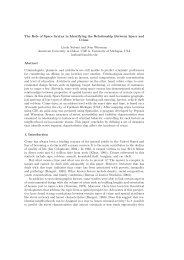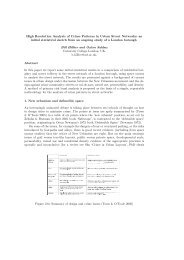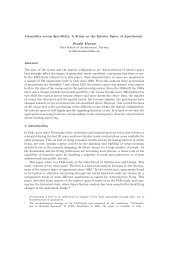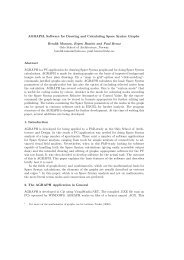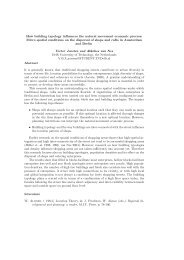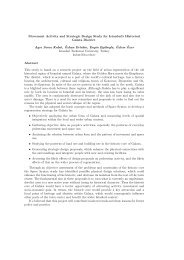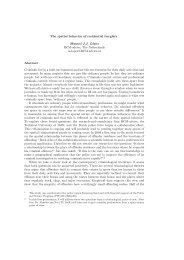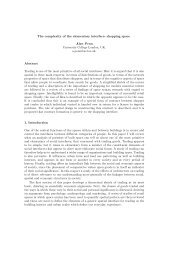Seen in a different light. Icons in Byzantine museums and churches ...
Seen in a different light. Icons in Byzantine museums and churches ...
Seen in a different light. Icons in Byzantine museums and churches ...
You also want an ePaper? Increase the reach of your titles
YUMPU automatically turns print PDFs into web optimized ePapers that Google loves.
<strong>Seen</strong> <strong>in</strong> a <strong>different</strong> <strong>light</strong>. <strong>Icons</strong> <strong>in</strong> Byzant<strong>in</strong>e <strong>museums</strong> <strong>and</strong> <strong>churches</strong><br />
Gianna Stavroulaki <strong>and</strong> John Peponis<br />
National Technical University of Athens, Greece, Georgia <strong>in</strong>stitute of technology, USA<br />
gstav 1@otenet.gr, john.peponis@arch.gatech.edu<br />
Abstract<br />
We analyze the pr<strong>in</strong>ciples that govern the visibility of icons <strong>in</strong> <strong>churches</strong> <strong>and</strong> <strong>museums</strong>. We<br />
develop methods for enrich<strong>in</strong>g visibility analysis by tak<strong>in</strong>g <strong>in</strong>to consideration not only the<br />
arrangement but also the illum<strong>in</strong>ation of space. F<strong>in</strong>ally, we suggest that there are some<br />
important differences between the view<strong>in</strong>g pr<strong>in</strong>ciples that apply <strong>in</strong> <strong>churches</strong>, as sites of<br />
primary familiarization, <strong>and</strong> <strong>museums</strong> as sites of recontextualization of icons.<br />
1. Introduction: the visual <strong>and</strong> spatial cultures <strong>in</strong> which icons are seen<br />
<strong>Icons</strong> seen <strong>in</strong> <strong>churches</strong> <strong>and</strong> <strong>in</strong> <strong>museums</strong> <strong>in</strong> Greece are set <strong>in</strong> very <strong>different</strong> visual <strong>and</strong><br />
spatial cultures. In the Byzant<strong>in</strong>e Museum of Athens icons are hanged on the walls or on<br />
transparent panels suspended on a grid. The aim is to provide visitors enter<strong>in</strong>g the room<br />
with a panoramic overview <strong>and</strong> many alternative paths so that they can choose where to<br />
focus their attention. Consistent with this aim there is abundant <strong>and</strong> diffused <strong>light</strong> which<br />
works with the simple hang<strong>in</strong>g arrangement to suggest a relatively homogeneous space.<br />
With<strong>in</strong> that space icons are serially arrayed as if <strong>in</strong> parataxis. The museum of Byzant<strong>in</strong>e<br />
Culture <strong>in</strong> Thessaloniki presents a <strong>different</strong> visual regime. The hang<strong>in</strong>g of icons on walls,<br />
niches <strong>and</strong> partitions does not conform to a clear overall grid. The room is rather dark<br />
<strong>and</strong> <strong>in</strong>dividual icons are illum<strong>in</strong>ated mostly by spot <strong>light</strong>s. Thus, icons are arranged <strong>in</strong><br />
multiple focal po<strong>in</strong>ts suggest<strong>in</strong>g a distributed collection. Evidently, the curators of the<br />
Museum of Byzant<strong>in</strong>e Culture <strong>in</strong> Thessaloniki have sought to reproduce someth<strong>in</strong>g of<br />
the atmosphere of the Byzant<strong>in</strong>e Church, while the curators <strong>in</strong> Athens have adapted<br />
the atmosphere which is more common <strong>in</strong> the art gallery. The deliberate <strong>in</strong>tent of the<br />
curators <strong>and</strong> exhibition designers is documented <strong>in</strong> the literature. Katsanika-Stefanou<br />
(2001), for example, recognizes the importance of relat<strong>in</strong>g one exhibit to another with<strong>in</strong><br />
an environment designed not only to convey <strong>in</strong>formation but also to suggest an appropriate<br />
“atmosphere”. The visual <strong>and</strong> spatial culture of the Byzant<strong>in</strong>e Church, however, appears<br />
<strong>different</strong> from either of these models.<br />
The Byzant<strong>in</strong>e Church, often composed as a cross plan with side isles <strong>and</strong> central<br />
dome provides a more articulated space than the typical museum environment. While the<br />
overall form is easy to comprehend <strong>and</strong> subject to fairly canonical pr<strong>in</strong>ciples, the play<br />
of <strong>light</strong> <strong>and</strong> shade creates a sense of gradual discovery as the mov<strong>in</strong>g visitor traces the<br />
unfold<strong>in</strong>g cont<strong>in</strong>uities <strong>and</strong> <strong>in</strong>tersections of surfaces. <strong>Icons</strong> complement the iconography on<br />
the walls <strong>and</strong> are found hanged on walls, pillars or partitions, or placed on st<strong>and</strong>s. Different<br />
icons st<strong>and</strong> out as one moves <strong>in</strong> the space, not merely because the undulations of shape<br />
create occlud<strong>in</strong>g edges to the visual fields, but also because the <strong>in</strong>terplay of <strong>light</strong> <strong>and</strong> shade<br />
makes <strong>different</strong> icons visible from <strong>different</strong> places. The importance of <strong>light</strong> as a device that<br />
structures church space is amply acknowledged <strong>in</strong> the literature. On the basis of a study
252 G. Stavroulaki <strong>and</strong> J. Peponis<br />
of <strong>light</strong> <strong>in</strong> a sample of <strong>churches</strong>, for example, Potamianos (2000) has argued that <strong>light</strong> was<br />
deliberately manipulated by designers. The dome br<strong>in</strong>gs the image of the almighty, which<br />
is typically pa<strong>in</strong>ted on it, <strong>in</strong>to greater illum<strong>in</strong>ation; the <strong>in</strong>tensity of <strong>light</strong>ly is gradually<br />
reduced as the gaze shifts downwards towards the depictions of episodes from the life of<br />
Christ, the evangelists <strong>and</strong> the sa<strong>in</strong>ts. While the image of the almighty was illum<strong>in</strong>ated<br />
consistently throughout the day other images were more transiently illum<strong>in</strong>ated over the<br />
course of the day, <strong>and</strong> <strong>in</strong> some cases over the course of the year. The variation of <strong>light</strong><strong>in</strong>g<br />
conditions <strong>and</strong> of consequent impressions accord<strong>in</strong>g to one’s position <strong>in</strong> the church was<br />
also recognized <strong>and</strong> seen as consistent with the notion that god is revealed <strong>in</strong> <strong>different</strong><br />
ways to <strong>different</strong> people.<br />
Thus, <strong>in</strong> the church, icons are arranged <strong>in</strong> a configuration which emerges accord<strong>in</strong>g to<br />
<strong>light</strong> <strong>and</strong> movement, they st<strong>and</strong> out <strong>and</strong> they recede <strong>in</strong>to the background accord<strong>in</strong>g to<br />
patterns which are the by product of the arrangement of space, they act as accentuations<br />
of space as well as objects of <strong>in</strong>terest <strong>in</strong> their own right. This configurational pattern <strong>and</strong><br />
its contrast to the pr<strong>in</strong>ciples of parataxis or collection mentioned earlier poses a number<br />
of methodological <strong>and</strong> theoretical questions which are the ma<strong>in</strong> topic of this paper.<br />
1. Spatial fields <strong>and</strong> the structure of po<strong>in</strong>ts of view<br />
The primary question to be addressed is the relationship between a po<strong>in</strong>t of view <strong>and</strong><br />
the spatial arrangement with<strong>in</strong> which it is def<strong>in</strong>ed. Should we simply th<strong>in</strong>k of spatial<br />
arrangements as <strong>in</strong>terrelated <strong>and</strong> <strong>in</strong>terdependent po<strong>in</strong>ts of view? From the perspective of<br />
space syntax it is tempt<strong>in</strong>g to give a positive answer. After all, when we take each node of<br />
a graph as a root <strong>and</strong> arrange other nodes along successive horizontal l<strong>in</strong>es accord<strong>in</strong>g to<br />
the number of transitions that are needed to reach them from the root (Hillier, 1996), a<br />
rather powerful theoretical idea is stated: a configuration can be def<strong>in</strong>ed as a set of <strong>different</strong><br />
relations between part <strong>and</strong> whole, so that the configuration “looks <strong>different</strong>” depend<strong>in</strong>g on<br />
“where one st<strong>and</strong>s”. In the st<strong>and</strong>ard practice of draw<strong>in</strong>g “justified graphs” the expression<br />
“looks <strong>different</strong>” applies literally to the representation, <strong>and</strong> more metaphorically to the<br />
reality be<strong>in</strong>g represented. Thus, the connectivity between spaces is only locally a matter of<br />
visual relationships; hence it is commonly affirmed that space syntax deals with topological<br />
rather than visual patterns. But if we take the visibility polygon rather than the convex<br />
space or the l<strong>in</strong>e of movement as a start<strong>in</strong>g po<strong>in</strong>t <strong>and</strong> if we analyze a visibility graph as a<br />
pattern of <strong>in</strong>tersect<strong>in</strong>g visibility polygons, can we not arrive at a more literal <strong>in</strong>terpretation<br />
of a configuration as <strong>in</strong>terdependent <strong>and</strong> <strong>different</strong>iated po<strong>in</strong>ts of view? We will suggest<br />
that such an approach would be only partially fruitful when we confront modes of spatial<br />
configuration such as the one presented <strong>in</strong> the relatively simple but <strong>in</strong>terest<strong>in</strong>g example<br />
of the Byzant<strong>in</strong>e Church. Consequently, we propose ways to augment it.<br />
Consistent with the arguments presented by Peponis, Karadima <strong>and</strong> Bafna (2003) <strong>and</strong><br />
by Stavroulaki <strong>and</strong> Peponis (2003), we will suggest that we should take layered rather<br />
than simple descriptions as the start<strong>in</strong>g po<strong>in</strong>t for deal<strong>in</strong>g with the relationship between<br />
spatial configuration <strong>and</strong> po<strong>in</strong>t of view. In practical terms, what this means is that any<br />
representation of a po<strong>in</strong>t of view, such as a visibility polygon or a section of a visibility<br />
polygon represent<strong>in</strong>g a visual cone, has to be set aga<strong>in</strong>st the background of several alternative<br />
representations of the spatial doma<strong>in</strong> under consideration. It is not sufficient to<br />
represent how visibility polygons <strong>in</strong>tersect each other with<strong>in</strong> a spatial doma<strong>in</strong>. We must<br />
also consider how they <strong>in</strong>tersect any number of relevant <strong>and</strong> overlapp<strong>in</strong>g fields that are
<strong>Seen</strong> <strong>in</strong> a <strong>different</strong> <strong>light</strong> 253<br />
Figure 105: Layers of spatial analysis of Capnicarea: a. Visual connectivity, b. Light<strong>in</strong>g<br />
levels, c. Visual <strong>in</strong>tegration, d. Intersect<strong>in</strong>g gazes
254 G. Stavroulaki <strong>and</strong> J. Peponis<br />
def<strong>in</strong>ed with<strong>in</strong> the doma<strong>in</strong>. We will <strong>in</strong>troduce this proposition more fully by tak<strong>in</strong>g the<br />
Church of Capnikarea, built <strong>in</strong> the 11th century <strong>and</strong> located at the center of Athens, as<br />
an example.<br />
For economy of presentation, we will <strong>in</strong>troduce only the three layers of description that<br />
are fundamental to the subsequent argument. The church will be represented as: first, a<br />
field of <strong>in</strong>ter-visible positions us<strong>in</strong>g Alasdair Turner’s visibility graph analysis software,<br />
Depth Map; second, a field of illum<strong>in</strong>ation levels us<strong>in</strong>g Dr Andrew March’s (Square1<br />
research PTY LTD) <strong>light</strong><strong>in</strong>g analysis software, Ecotect; third, a field of <strong>in</strong>tersect<strong>in</strong>g gazes<br />
projected from the dom<strong>in</strong>ant persons shown <strong>in</strong> each wall pa<strong>in</strong>t<strong>in</strong>g or icon. This triad<br />
corresponds to a deliberate theoretical choice. We want to look at the church as a set<br />
of generic spatial relationships aris<strong>in</strong>g from its shape (visibility graph analysis), as a set<br />
of generic perceptual relationships aris<strong>in</strong>g from the manner <strong>in</strong> which the church admits<br />
day<strong>light</strong> (<strong>light</strong><strong>in</strong>g analysis), <strong>and</strong> a set of <strong>in</strong>tentional programmatic spatial relationships (the<br />
manner <strong>in</strong> which represented holy persons “look out” towards the space of congregation.)<br />
The decision to map gazes is not arbitrary. The “face to face” reciprocity between the<br />
gaze emanat<strong>in</strong>g from the pa<strong>in</strong>t<strong>in</strong>g <strong>and</strong> the gaze of the visitor is seen as fundamental<br />
to the religious bond by a number of authors (Eudokimof, 1972; Giannis E, 1996). The<br />
relationship between iconography <strong>and</strong> <strong>light</strong> is also a frequent theme <strong>in</strong> the literature with<br />
authors discuss<strong>in</strong>g both the symbolic association between god <strong>and</strong> <strong>light</strong> (Brotherhood of<br />
Monastery of Prodromos <strong>in</strong> Careas, 2000) <strong>and</strong> the manner <strong>in</strong> which Byzant<strong>in</strong>e pa<strong>in</strong>t<strong>in</strong>g<br />
styles emphasize <strong>light</strong> over shad<strong>in</strong>g (Skliris, 1991).<br />
2. Visual fields, <strong>light</strong><strong>in</strong>g fields, gazes<br />
When we look at the church as a spatial field def<strong>in</strong>ed by built shape <strong>and</strong> as a spatial field<br />
result<strong>in</strong>g from the distribution of <strong>light</strong> a significant polarity emerges. The best illum<strong>in</strong>ated<br />
areas (figure 105b) correspond to the outer-narthex, that is the transverse zone of space<br />
attached to the entrance; more limited areas of high illum<strong>in</strong>ation occur under the domes<br />
of the church <strong>and</strong> side chapel (the diagram is based on an analysis on a scale 0-300 lux,<br />
performed for <strong>light</strong><strong>in</strong>g conditions prevail<strong>in</strong>g on November 11, 11.30 am). The locations<br />
from which a greater part of the church would be directly visible had <strong>light</strong> been evenly<br />
distributed (greatest visibility polygon area) are mostly situated under the dome <strong>and</strong><br />
extend outwards to the edge along a longitud<strong>in</strong>al <strong>and</strong> a transverse axis (figure 105a) - the<br />
visually more <strong>in</strong>tegrated locations (figure 1c) follow the same pattern. Thus the core of<br />
best lit space <strong>and</strong> the core of potentially more panoramic views do not co<strong>in</strong>cide but reach<br />
towards each other from opposite poles. From the entrance, one senses the presence of<br />
greater space further <strong>in</strong>, but that space has to be discovered as it is veiled by darkness.<br />
Under the dome one is situated with<strong>in</strong> a smaller node of <strong>light</strong> <strong>and</strong> surrounded by darker<br />
space, with glimpses of the well lit outer narthex <strong>in</strong> the background.<br />
The gazes emanat<strong>in</strong>g from the wall pa<strong>in</strong>t<strong>in</strong>gs <strong>and</strong> the icons <strong>in</strong>tersect to create a network<br />
that covers the whole church. Whether we consider only the gazes that emanate from eye<br />
level or s<strong>light</strong>ly higher (fig 105d cont<strong>in</strong>uous l<strong>in</strong>es) or also <strong>in</strong>clude the gazes descend<strong>in</strong>g<br />
from the higher zone of the church (<strong>in</strong>clud<strong>in</strong>g the dome <strong>and</strong> the apses) (fig 105d dotted<br />
l<strong>in</strong>es), the denser web of <strong>in</strong>tersections occurs just off the <strong>in</strong>ner side of the narthex, as if to<br />
mediate between the zone of greater illum<strong>in</strong>ation <strong>and</strong> the zone of more panoramic views.<br />
We analyzed the network of <strong>in</strong>tersect<strong>in</strong>g gazes as if it was an axial map <strong>and</strong> observed<br />
an <strong>in</strong>terest<strong>in</strong>g difference accord<strong>in</strong>g to whether the gazes emanat<strong>in</strong>g from the higher zone
<strong>Seen</strong> <strong>in</strong> a <strong>different</strong> <strong>light</strong> 255<br />
Figure 106: Icon-exposure polygons: a. from icon 1, b. from icon 2<br />
are excluded or <strong>in</strong>cluded. When they are excluded, the connectivity <strong>and</strong> <strong>in</strong>tegration cores<br />
grow from the <strong>in</strong>terface between the narthex <strong>and</strong> the ma<strong>in</strong> body if the church <strong>in</strong>ward<br />
(figures 105a <strong>and</strong> b), along the side aisles; when they are <strong>in</strong>cluded, the grow <strong>in</strong> a similar<br />
manner but predom<strong>in</strong>antly along the central axis that runs under the ma<strong>in</strong> dome (figures<br />
105c <strong>and</strong> d). Thus, if we assume the visitors to look up as well as around, the pattern<br />
of gazes would draw them from the edge towards the center <strong>and</strong> the ma<strong>in</strong> dome, where<br />
they would meet the gaze of the almighty; if we assume visitors look<strong>in</strong>g around only, the<br />
pattern of gazes would draw them around but not through the center of the plan. In the<br />
former case, the gazes would connect the zone of abundant lateral <strong>light</strong>, by the entrance,<br />
to the zone of <strong>light</strong> com<strong>in</strong>g from above, under the dome. In the latter, the gazes would<br />
lead visitors from the zone of abundant <strong>light</strong> to the zones of greater darkness.<br />
The configuration of co-visibility of icons can only be understood when set aga<strong>in</strong>st<br />
the background of these three descriptive layers. In the next section we will look at the<br />
manner <strong>in</strong> which <strong>in</strong>dividual visibility polygons <strong>in</strong>tersect the three fields described here.<br />
3. Visibility polygons from <strong>and</strong> visibility polygons towards icons<br />
Two icons, marked “1” <strong>and</strong> “2” are selected as examples for the next stage of the analysis.<br />
Their position <strong>in</strong> space is first described accord<strong>in</strong>g to the visibility polygon that has each of<br />
them as a root (figures 106a <strong>and</strong> b). These “icon-exposure” or “from-icon” polygons cover<br />
all the areas from which the icons are potentially visible, depend<strong>in</strong>g on actual <strong>light</strong><strong>in</strong>g<br />
conditions. They are quite <strong>in</strong>formative <strong>in</strong> their own right. For example, they are both<br />
characterized by several spokes extend<strong>in</strong>g <strong>in</strong> <strong>different</strong> directions; some of the spokes have<br />
long radii <strong>and</strong> penetrate far <strong>in</strong>to the church - <strong>in</strong> the case of icon-1 the spokes reach all<br />
peripheral edges. Thus, each of the icons is potentially visible discont<strong>in</strong>uously as one moves<br />
about the church <strong>and</strong> from a variety of angles <strong>and</strong> distances.<br />
The “icon-exposure” polygons do not fully capture the configurational dimensions<br />
of the manner <strong>in</strong> which icons become visible <strong>in</strong> their spatial context. A more complete<br />
analysis requires that we draw visibility polygons from various particular positions on the<br />
“exposure polygons”, to help us study the manner <strong>in</strong> which icons are seen. We will call
256 G. Stavroulaki <strong>and</strong> J. Peponis<br />
Figure 107: Selected view<strong>in</strong>g positions (black, grey <strong>and</strong> white st<strong>and</strong> for dist<strong>in</strong>ct, <strong>in</strong>dist<strong>in</strong>ct<br />
<strong>and</strong> elusive visibility;) a. icon 1, b. icon 2<br />
these “icon-capture” or “to-icon” polygons. In order to draw them we have followed a set of<br />
conventions. First, we have taken the icon-exposure polygons <strong>and</strong> drawn radials from their<br />
centers at angle <strong>in</strong>tervals of 30, 60, 90, 120 <strong>and</strong> 150 degrees. Second, we identified po<strong>in</strong>ts<br />
along these radials at vary<strong>in</strong>g distances, near, far <strong>and</strong> <strong>in</strong>terim. These, otherwise arbitrary,<br />
conventions allowed us to sample the variety of positions from which <strong>and</strong> conditions under<br />
which each of the icons is visible (figures 107a <strong>and</strong> b).<br />
The effects of <strong>light</strong> are such that the two icons are not dist<strong>in</strong>ctly visible from all positions<br />
on the icon-exposure polygons. Positions of dist<strong>in</strong>ct visibility, mean<strong>in</strong>g that the<br />
figure <strong>and</strong> face of the sa<strong>in</strong>t are recognizable, are marked as black circles or squares; positions<br />
of elusive visibility, mean<strong>in</strong>g that one suspects the presence of an icon without be<strong>in</strong>g<br />
able to see a figure or a face, are marked as white circles or squares; positions of <strong>in</strong>dist<strong>in</strong>ct<br />
visibility, mean<strong>in</strong>g that one sees a figure but not a face, are marked as grey circles<br />
or squares. Thus, icon 1, even though axially exposed, is only dist<strong>in</strong>ctly visible when one<br />
st<strong>and</strong>s rather near it <strong>and</strong> elusively visible when directly faced from <strong>in</strong>termediate positions.<br />
This is due to the glare caused by the small w<strong>in</strong>dow over it. Even more <strong>in</strong>terest<strong>in</strong>gly, a<br />
peripheral zone of elusive visibility mediates between the <strong>in</strong>ner zone of dist<strong>in</strong>ct visibility<br />
<strong>and</strong> an outer zone of <strong>in</strong>dist<strong>in</strong>ct visibility. This means that from a perceptual po<strong>in</strong>t of view,<br />
the icon cannot be “approached directly”. On most direct paths of approach that might<br />
orig<strong>in</strong>ate from an <strong>in</strong>dist<strong>in</strong>ct far view, the icon would fade due to glare before re-emerg<strong>in</strong>g<br />
towards the end of the path; even the apparent radial directional cont<strong>in</strong>uity of access is<br />
punctuated by a discont<strong>in</strong>uity of perceptual experience. The discont<strong>in</strong>uity of perception<br />
complements the more evident discont<strong>in</strong>uities of exposure that are revealed by look<strong>in</strong>g at<br />
dist<strong>in</strong>ct spokes of the icon-exposure polygon.<br />
The full effects of <strong>light</strong>, however, only come to the fore when we look at the co-visibility<br />
of icons <strong>and</strong> wall pa<strong>in</strong>t<strong>in</strong>gs as revealed by study<strong>in</strong>g icon-capture visibility polygons. On<br />
each of these polygons we have marked other icons or pa<strong>in</strong>t<strong>in</strong>gs that are dist<strong>in</strong>ctly visible<br />
(thick black l<strong>in</strong>es), <strong>in</strong>dist<strong>in</strong>ctly visible (thick grey l<strong>in</strong>es) or elusively visible (<strong>light</strong> grey<br />
l<strong>in</strong>es) We have also <strong>in</strong>dicated the 60 degree cone of vision that encompasses the icon<br />
under study (icon 1 or icon 2) as well as the 180 degree horizon of view when the icon<br />
is at the focus of attention. From some positions (figure 108a) the icon of reference is
<strong>Seen</strong> <strong>in</strong> a <strong>different</strong> <strong>light</strong> 257<br />
Figure 108: Icon- capture polygons to icon 1(black, grey <strong>and</strong> <strong>light</strong> grey l<strong>in</strong>es st<strong>and</strong> for<br />
dist<strong>in</strong>ct, <strong>in</strong>dist<strong>in</strong>ct <strong>and</strong> elusive icons <strong>and</strong> wall-pa<strong>in</strong>t<strong>in</strong>gs)<br />
dist<strong>in</strong>ctly visible, while other icons or pa<strong>in</strong>t<strong>in</strong>gs fall <strong>in</strong>to the cone of vision dist<strong>in</strong>ctly <strong>and</strong><br />
<strong>in</strong>dist<strong>in</strong>ctly; at the same time there are many more icons visible with<strong>in</strong> the visual horizon<br />
<strong>and</strong> some additional icons or pa<strong>in</strong>t<strong>in</strong>gs that are potentially visible if one rotates. There<br />
are other positions from which the icon of reference is elusively visible (figure 108b), but<br />
another pa<strong>in</strong>t<strong>in</strong>g is dist<strong>in</strong>ctly visible with<strong>in</strong> the cone of vision, some additional pa<strong>in</strong>t<strong>in</strong>gs<br />
appear with<strong>in</strong> the horizon, <strong>and</strong> many more become visible if one rotates. F<strong>in</strong>ally, there are<br />
positions from which only the icon of reference is dist<strong>in</strong>ctly visible with<strong>in</strong> the visual cone<br />
(figure 108c) while other icons or pa<strong>in</strong>t<strong>in</strong>gs appear only <strong>in</strong>dist<strong>in</strong>ctly; still, several other<br />
pa<strong>in</strong>t<strong>in</strong>gs or icons are dist<strong>in</strong>ctly visible with<strong>in</strong> the horizon. A similar range of conditions<br />
prevail regard<strong>in</strong>g icon 2 (figure 109). From view<strong>in</strong>g po<strong>in</strong>ts <strong>in</strong> the narthex, icon two appears<br />
prom<strong>in</strong>ently with other icons rema<strong>in</strong><strong>in</strong>g <strong>in</strong>dist<strong>in</strong>ctly or elusively visible. The only other<br />
dist<strong>in</strong>ctly visible icons are on a higher level <strong>and</strong> attract the gaze upwards. One of the icons<br />
situated at the threshold between the narthex <strong>and</strong> the ma<strong>in</strong> church is usually dist<strong>in</strong>ctly<br />
visible when visible at all, as if to encourage the visitor to move <strong>in</strong>wards. In short, icon 2<br />
seems to play a role <strong>in</strong> prepar<strong>in</strong>g visitors for enter<strong>in</strong>g the ma<strong>in</strong> church.
258 G. Stavroulaki <strong>and</strong> J. Peponis<br />
Figure 109: Icon- capture polygons to icon 2 (black, grey <strong>and</strong> <strong>light</strong> grey l<strong>in</strong>es st<strong>and</strong> for<br />
dist<strong>in</strong>ct, <strong>in</strong>dist<strong>in</strong>ct <strong>and</strong> elusive icons <strong>and</strong> wall-pa<strong>in</strong>t<strong>in</strong>gs)
<strong>Seen</strong> <strong>in</strong> a <strong>different</strong> <strong>light</strong> 259<br />
4. The spatial structure of a visual regime<br />
The most fundamental effect of <strong>light</strong> is that it enables us to dist<strong>in</strong>guish between potential<br />
co-visibility, comparative co-visibility, relative visual prom<strong>in</strong>ence <strong>and</strong> relative visual attenuation,<br />
<strong>in</strong> relation to an object -<strong>in</strong> this case an icon- of reference. Potential co-visibility is<br />
associated with ly<strong>in</strong>g on the edge of the same visibility polygon, better still, on the same<br />
side of the horizon of an oriented visibility polygon, or better still with<strong>in</strong> the visual cone<br />
of an oriented visibility polygon. Comparative co-visibility arises when icons <strong>in</strong> addition<br />
to the reference icon become dist<strong>in</strong>ctly visible with<strong>in</strong> the cone of vision, or the horizon of a<br />
visibility polygon. Relative prom<strong>in</strong>ence arises when the icon of reference is more dist<strong>in</strong>ctly<br />
visible than other icons with<strong>in</strong> the visual cone or the visual horizon of a visibility polygon.<br />
Relative attenuation arises when the icon of reference is <strong>in</strong>dist<strong>in</strong>ctly or elusively visible<br />
with<strong>in</strong> the cone of vision, but other icons become dist<strong>in</strong>ctly visible with<strong>in</strong> the visual horizon<br />
or the cone itself. The po<strong>in</strong>t, at this stage of development of our methodology, is not to<br />
immediately decide whether this list is exhaustive, or whether it appropriately captures<br />
significant conditions. Rather, the po<strong>in</strong>t is that these dist<strong>in</strong>ctions cannot be drawn by<br />
consider<strong>in</strong>g polygons of exposure <strong>and</strong> of capture, without also consider<strong>in</strong>g the underly<strong>in</strong>g<br />
fields not only of shaped space but also of illum<strong>in</strong>ated space.<br />
We can now summarize the visual regime that applies to the icon’s exposure. As one<br />
moves about church space, icons come <strong>in</strong>to varied relationships of potential co-visibility,<br />
comparative co-visibility, relative prom<strong>in</strong>ence <strong>and</strong> relative attenuation. Changes of condition<br />
occur not only as one crosses thresholds of exposure (the appearance <strong>and</strong> disappearance<br />
of objects beh<strong>in</strong>d occlud<strong>in</strong>g edges), but also as one crosses perceptual thresholds<br />
aris<strong>in</strong>g due to the distribution of <strong>light</strong> that punctuate otherwise un<strong>in</strong>terrupted space <strong>and</strong><br />
otherwise unaffected relations of potential visibility. The changes are distributed over the<br />
entire <strong>in</strong>terior space. More importantly, they are unexpected <strong>and</strong> appear r<strong>and</strong>om. The<br />
space is <strong>in</strong>vested with iconography <strong>in</strong> such a way that even though its architectural composition<br />
is simple <strong>and</strong> easily <strong>in</strong>telligible, its experiential elaboration is complex <strong>and</strong> <strong>in</strong>vites<br />
discovery. The actual exposure of icons is clearly subord<strong>in</strong>ate to the <strong>in</strong>terplay of shape,<br />
space <strong>and</strong> <strong>light</strong>. In turn, the experientially relevant structure of space results from the<br />
presence of icons, wall pa<strong>in</strong>t<strong>in</strong>gs <strong>and</strong> the gazes that emanate from them. Museums of<br />
Byzant<strong>in</strong>e art do not seek, or do not succeed <strong>in</strong> reproduc<strong>in</strong>g this underly<strong>in</strong>g structure of<br />
experience.<br />
5. Fields, thresholds, marks<br />
The visual regime described above arises from the superimposition <strong>and</strong> enmesh<strong>in</strong>g of the<br />
three fields identified earlier, the field of spatial relationships aris<strong>in</strong>g from built shape, the<br />
field of illum<strong>in</strong>ated space <strong>and</strong> the field of <strong>in</strong>tersect<strong>in</strong>g gazes. The <strong>in</strong>terplay of these fields<br />
<strong>in</strong> the church can be perhaps be further understood by draw<strong>in</strong>g a comparison to exhibition<br />
patterns at Castelvecchio which were analyzed <strong>in</strong> similar, but methodologically more<br />
primitive ways (Stavroulaki <strong>and</strong> Peponis, 2003). The pattern of co-visibility of statues<br />
<strong>and</strong> their <strong>in</strong>tersect<strong>in</strong>g gazes are as important to the spatial experience of Castelvecchio<br />
as the correspond<strong>in</strong>g patterns associated with icons are to Capnicarea. At Castlevecchio,<br />
however, the gazes of statues <strong>in</strong>terest so as to identify a relatively small set of significant<br />
positions, which act as counterpo<strong>in</strong>t to the ma<strong>in</strong> axes of movement <strong>and</strong> the positions from<br />
which more panoramic views are afforded. The effect is to punctuate a space which would<br />
otherwise be simply l<strong>in</strong>ear (from room to room) <strong>and</strong> simply hierarchical (from central axis
260 G. Stavroulaki <strong>and</strong> J. Peponis<br />
to perimeter) by add<strong>in</strong>g some “<strong>in</strong>visible local thresholds” of special <strong>in</strong>tensity. At Capnicarea,<br />
by contrast, thresholds are more entropically distributed. The overrid<strong>in</strong>g effect is<br />
not to emphasize the significance of the thresholds, but rather to make visitors aware of<br />
the cont<strong>in</strong>uous <strong>in</strong>terplay of the three underly<strong>in</strong>g spatial fields. In this regard, Castelvecchio<br />
<strong>and</strong> Capnicarea offer an <strong>in</strong>terest<strong>in</strong>g, if perhaps highly eclectic, contrast. We might<br />
<strong>in</strong>tuitively say that Castelvecchio stages the view<strong>in</strong>g subjects <strong>in</strong> relation to the art, while<br />
Capnicarea immerses them. Stag<strong>in</strong>g would imply the com<strong>in</strong>g to occupy prom<strong>in</strong>ent positions,<br />
the com<strong>in</strong>g <strong>in</strong>to focus with respect to def<strong>in</strong>ite <strong>and</strong> special relationships. Immers<strong>in</strong>g<br />
would imply a cont<strong>in</strong>uous movement <strong>in</strong> a field of cont<strong>in</strong>uous transformations, as described<br />
here.<br />
The stag<strong>in</strong>g <strong>and</strong> immers<strong>in</strong>g of subjects would be varieties of highly embodied experience,<br />
entail<strong>in</strong>g an engagement of movement, see<strong>in</strong>g <strong>and</strong> feel<strong>in</strong>g. This bears on a fundamental<br />
characteristic which the two sett<strong>in</strong>gs have <strong>in</strong> common. No attempt is made to mark, to<br />
architecturally underscore, any of the experiential <strong>and</strong> perceptual thresholds <strong>in</strong> question.<br />
The thresholds only become apparent as subjects become attentive to the relevant properties<br />
of spatial fields <strong>and</strong> as they come to occupy particular positions. In fact, the primacy<br />
of embodied experience arises precisely because of the non-correspondence between two<br />
k<strong>in</strong>ds of thresholds: first, the thresholds which are overtly def<strong>in</strong>ed by the build<strong>in</strong>g (for<br />
example, the transition between rooms <strong>in</strong> Castelvecchio, the def<strong>in</strong>ition of the ma<strong>in</strong> part<br />
of the church under the dome <strong>in</strong> Capnicarea); <strong>and</strong> second, the thresholds created by the<br />
<strong>in</strong>terplay of spatial relationships of potential co-visibility, <strong>light</strong><strong>in</strong>g <strong>and</strong> <strong>in</strong>tersect<strong>in</strong>g gazes.<br />
6. Museum recontextualization<br />
In contrast to the church, the ma<strong>in</strong> room of the Byzant<strong>in</strong>e museum <strong>in</strong> Athens which is<br />
devoted to icons is a simple large rectangle with no <strong>in</strong>ternal subdivisions, other than those<br />
produced by hang<strong>in</strong>g the icons themselves. Most of the icons exhibited are taken from<br />
the chancel screen of the church; thus they have two rather special characteristics. First,<br />
the gazes emanat<strong>in</strong>g from them are usually, even though not exclusively frontal as is the<br />
tendency <strong>in</strong> icons specifically <strong>in</strong>tended for that particular location. Second, icons are often<br />
double sided. In figure 110a we show the field of visible area <strong>and</strong> <strong>in</strong> figure 110b we show<br />
the field of gazes. There is no need to show the <strong>light</strong> field as <strong>light</strong><strong>in</strong>g is artificial <strong>and</strong><br />
illum<strong>in</strong>ation uniformly bright.<br />
The room is organized so as to echo the aspects of the zon<strong>in</strong>g of space of the church.<br />
There is a layer of space immediately adjacent to the entrance, similar to the outer narthex,<br />
<strong>and</strong> a second parallel layer similar to the <strong>in</strong>ner narthex, followed by a larger <strong>and</strong> more<br />
compact area, analogous to the ma<strong>in</strong> church. Furthermore, there is a central axis of longitud<strong>in</strong>al<br />
symmetry. This, however, is where similarities end. The most panoramic views<br />
are afforded at the threshold between the second layer <strong>and</strong> the <strong>in</strong>ner space. Gazes <strong>in</strong>tersect<br />
more densely with<strong>in</strong> the second layer itself. Thus, the larger area of the <strong>in</strong>ner space<br />
emphasizes the potential importance of the relatively fewer icons displayed towards it. In<br />
this <strong>in</strong>stance, greater space works to imply greater importance without enabl<strong>in</strong>g a more<br />
<strong>in</strong>tricate pattern of exploration. While church space seems to be implicitly didactic by<br />
explicitly creat<strong>in</strong>g a field of immersion, museum space seems explicitly didactic by express<strong>in</strong>g,<br />
<strong>in</strong> the uneven distribution of area, an implicit hierarchy of value. This seems to<br />
be simultaneously artistic <strong>and</strong> symbolic. All icons are artistically significant, the last pair,<br />
which is emphasized by the arrangement, shows Jesus <strong>and</strong> the Virg<strong>in</strong> Mary.
<strong>Seen</strong> <strong>in</strong> a <strong>different</strong> <strong>light</strong> 261<br />
Figure 110: Layers of spatial analysis of the ma<strong>in</strong> room of icons <strong>in</strong> Byzant<strong>in</strong>e Museum of<br />
Athens; a. Visual connectivity, b. Intersect<strong>in</strong>g gazes.
262 G. Stavroulaki <strong>and</strong> J. Peponis<br />
Figure 111: Icon- exposure <strong>and</strong> icon-capture polygons <strong>in</strong> the museum: a. icon-exposure<br />
polygon from icon 1; b. icon-capture polygon to icon 1; c. icon-exposure polygon from<br />
icon 2; d. icon-capture polygon to icon 2<br />
There is an even more important difference which becomes clearer when we consider<br />
the polygons of exposure <strong>and</strong> capture that correspond to two icons (figure 111). The<br />
arrangement of icons is such that any two icons which are co-visible are fac<strong>in</strong>g the same<br />
way. The closer one approaches an icon, the greater the likelihood that other icons near<br />
the 60 degree cone of vision will appear deeper <strong>in</strong>to the layered space, as if <strong>in</strong>vit<strong>in</strong>g the<br />
visitor to move forward. The more one steps back from an icon, while still rema<strong>in</strong><strong>in</strong>g <strong>in</strong> its<br />
vic<strong>in</strong>ity, the greater the chances that it can be compared to adjacent co-planar icons. Thus,<br />
the entire arrangement works to <strong>in</strong>vite comparisons as well as the careful exam<strong>in</strong>ation of<br />
<strong>in</strong>dividual icons; movement is encouraged not only <strong>in</strong> the <strong>in</strong>terests of exhaustive view<strong>in</strong>g<br />
of the collection but also <strong>in</strong> the <strong>in</strong>terests of comparative view<strong>in</strong>g. <strong>Icons</strong> are alternatively<br />
seen <strong>in</strong> patterns of simultaneity <strong>and</strong> as s<strong>in</strong>gle objects. However, as the comparative field<br />
is cultivated by the curators <strong>and</strong> designers, so the possibilities of relative prom<strong>in</strong>ence <strong>and</strong><br />
relative attenuation are elim<strong>in</strong>ated. In simple language, the mode of see<strong>in</strong>g has to do more<br />
with the exam<strong>in</strong>ation of displays <strong>and</strong> less with position<strong>in</strong>g the subject. This is consistent<br />
with the shift <strong>in</strong> the underly<strong>in</strong>g cultural program: icons are now be<strong>in</strong>g presented primarily<br />
as works of art. Their nature as objects of devotion is relegated to the <strong>in</strong>terpretative<br />
context of explanation; it is no longer presented <strong>in</strong> the arrangement of approaches <strong>and</strong><br />
views.
<strong>Seen</strong> <strong>in</strong> a <strong>different</strong> <strong>light</strong> 263<br />
7. Conclud<strong>in</strong>g comments<br />
The preced<strong>in</strong>g analysis <strong>in</strong>troduces, rather than resolves, the methodological issues raised<br />
by the comparison between <strong>museums</strong> of Byzant<strong>in</strong>e art, as sites of re-contextualization<br />
of icons, <strong>and</strong> Byzant<strong>in</strong>e <strong>churches</strong> as sites of orig<strong>in</strong>al formation of the visual regime for<br />
view<strong>in</strong>g icons. We have not addressed the question of the impact that these properties<br />
have on visitors, not have we sought to <strong>in</strong>terpret the significance of these properties from<br />
the po<strong>in</strong>t of view of a cultural, theological, art historical or museological <strong>in</strong>terpretation.<br />
Regard<strong>in</strong>g both the impact of these properties upon visitors <strong>and</strong> the possible extensions of<br />
the argument towards <strong>in</strong>terpretation, we have limited ourselves to offer<strong>in</strong>g h<strong>in</strong>ts. Our ma<strong>in</strong><br />
emphasis has been upon show<strong>in</strong>g how certa<strong>in</strong> properties can be def<strong>in</strong>ed <strong>and</strong> systematically<br />
represented. Our argument depends upon dist<strong>in</strong>guish<strong>in</strong>g <strong>different</strong> spatial fields <strong>in</strong> order to<br />
study the pattern of their overlap <strong>and</strong> <strong>in</strong>tersection; also upon dist<strong>in</strong>guish<strong>in</strong>g “exposure”<br />
<strong>and</strong> “capture” visibility polygons associated with <strong>in</strong>dividual displays. We are still <strong>in</strong> the<br />
process of develop<strong>in</strong>g possible measures of some of the properties that have <strong>in</strong>troduced<br />
above. It seems clear to us, however, that the morphological analysis of museum sett<strong>in</strong>gs<br />
is open to cont<strong>in</strong>u<strong>in</strong>g extensions that help us describe modes of see<strong>in</strong>g rather than field<br />
of visibility alone; also the projection of specific see<strong>in</strong>g subjects rather than the mere<br />
def<strong>in</strong>ition of view<strong>in</strong>g positions. These issues are excit<strong>in</strong>g precisely because they help us<br />
make a transition which rema<strong>in</strong>s fundamental to much of the theory of space syntax: from<br />
a description of spatial arrangement to an account of spatial culture. 1<br />
Literature<br />
Brotherhood of the Monasteri of Prodromos at Careas, (2000) What do<br />
you know about icons, Athens, Etimasia Publishers.<br />
Eudokimof P. (1972) Orthodoxy, (<strong>in</strong> Greek), Thessaloniki, Rigopoulos Publishers.<br />
Giannis E. (1996) Pedagogue <strong>Icons</strong>, (<strong>in</strong> Greek), PhD. thesis, Flor<strong>in</strong>a.<br />
Hillier B. (1996) Space is the Mach<strong>in</strong>e, Cambridge, Cambridge University Press.<br />
Katsanika-Stefanou, H. (2001) From the “White Tower” Exhibition to the Museum<br />
of Byzant<strong>in</strong>e Culture: Applied Museology <strong>and</strong> Theoretical Pursuits, <strong>in</strong>: Skaltsa, M.<br />
(ed.), Museology Towards the 21st century: Theory <strong>and</strong> Practice, Thessaloniki, Endeftkirio<br />
publications, p. 243-248.<br />
Peponis J, Karadima C, Bafna S. (2003) On the formulation of spatial mean<strong>in</strong>g <strong>in</strong><br />
architectural design, <strong>in</strong>: J. Hanson(ed.), Fourth International Space Syntax Symposium,<br />
University College London , London, UK, p. 2.1-2.20.<br />
Potamianos I. (2000) Light <strong>in</strong> the Byzant<strong>in</strong>e Church,(<strong>in</strong> Greek), Thessaloniki, University<br />
Studio Press.<br />
Skliris S. (1991) In Inner Reflection, Athens, Grigoris Publishers.<br />
Stavroulaki G, Peponis J. (2003) The spatial construction of see<strong>in</strong>g at Castelvecchio,<br />
<strong>in</strong> Julienne Hanson ed. Fourth International Space Syntax Symposium, London<br />
UK, p. 66.1-66.14.<br />
1 This research has been supported by a Scholarship provided to the first author by the Greek State<br />
Scholarship Foundation.


